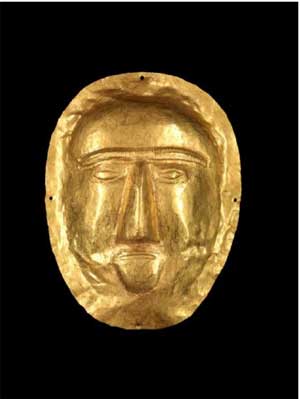
Funerary Mask, Thaj, Tell al-Zayer, Saudi Arabia, 1st century C.E. Gold, H x W: 6 11/12 x 5 1/12 inches. National Museum, Riyadh, 2061.
More than 200 recently excavated objects from Saudi Arabia are coming to the Nelson-Atkins Museum of Art.
The works that go on display April 25 have redefined knowledge and understanding of the pre-modern world, the museum said today in a press release.
There will also be a scent station where people can smell frankincense and myrrh, precious trade commodities that linked the Mesopotamian and Greco-Roman world.
Roads of Arabia: Archeology and History of the Kingdom of Saudi Arabia examines Saudi Arabia’s history before and after the rise of Islam.
The Nelson-Atkins is one of five venues in the United States to host the traveling exhibit.
“Lovers of art and history will marvel at the prehistoric stelae, colossal sculptures of Lihyanite kings, gold jewelry and luxurious objects, and elegant calligraphic works,” said Kimberly Masteller, co-curator of the exhibit. “Young adults, families and children will enjoy our interactive stations which will focus on archaeology, language and trade.”
Large scale sculptures from the Neolithic Age, the beginning of civilization, are presented, the release states.
The exhibition is divided into four subcategories, a progression from the area’s ancient to recent timeline.
Also from the release:
There will be pre-historic tools and sculpted figures and then items from the ancient Arabian civilizations that flourished by trade.
After the domestication of the camel in 1200 B.C., the incense routes allowed for commerce from the Horn of Africa to the Arabian peninsula to temples of royal courts in the Mediterranean and Near East.
Oases used for rest on these routes grew into large commercial hubs, and objects found in them indicate complex relationships between Arabs and neighbors who include the Egyptians, Syrians, Babylonians and Greco-Romans.
The third section deals with how routes from Arabia evolved into trails that led from cities such as Damascus, Cairo, Baghdad and Mecca.
The final section deals with the time period after the 1932 creation of the Kingdom of Saudi Arabia.
There will be a bit of a royal touch just before opening: An inaugural ceremony and private dinner will include His Royal Highness Prince Sultan bin Salman.



Who’s talking